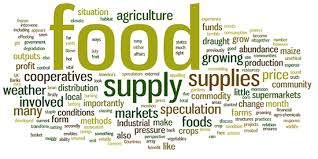Food+Tech Connect’s second annual Internet of Food Editorial Series
 I always am happy to be asked to participate in Food+Tech Connect’s annual internet of food editorial series. I am a huge fan of what they have built. Here is the question and answer to the piece I wrote for them this week. You can also read it here.
I always am happy to be asked to participate in Food+Tech Connect’s annual internet of food editorial series. I am a huge fan of what they have built. Here is the question and answer to the piece I wrote for them this week. You can also read it here.
“How might we use technology, new business models and design to guarantee healthy, safe and sufficient food for everyone?”
Unless you are a farmer or a passionate gardener, the food you are eating has passed through many hands before it got to you. Sure there are laws around how food should be handled, but we have read one too many times about someone getting sick from something they ate.
Technology has made it possible for us to track almost everything. Fast casual restaurants and grocery stores, for example, source products from multiple suppliers. In today’s age, the supply chain should be digitized and nothing should be done on paper anymore. Every grocery store and restaurant should make a pledge to exclusively accept supplies that have been tracked from their source to them. A commitment to using this kind of in-depth platform would make it much easier to track down bad food and in turn bad behavior across the supply chain. This information should be built on an open source platform or be made publicly available, so consumers can see where their food is coming from at, let’s say, Whole Food or Chipotle.
Overconsumption and waste are also big issues. Americans consume nearly one ton of food a year. What is more amazing is that about 40 percent of all food goes to waste. In addition to the health implications of eating one ton of food annually, this amount of food consumption also means more food is wasted at each stage of the supply chain. These stats underscore the need and opportunity for change.
There is a lot of waste across the supply chain, and we have to figure out how to use technology to become more efficient. But a lot of waste comes from consumer behavior. In Europe, for example, the portions are half the size of what they are in the U.S. But over the past 30 years, fast food portions have grown substantially, as have the prevalence of diet related disease. When I grew up diabetes was not rampant and neither was obesity. This is a consumer behavior issue. Using technology to give consumers more information about the food they are eating, the calories they are consuming and the supply chain that it is coming from, as well providing education around food has the potential to shift the insane amount of waste and the health of our nation.
With all of the technology that is available today, there is no reason that we can not guarantee healthy, safe and sufficient food for everyone.


Comments (Archived):
I love this and believe it’s so important. Thanks for writing and sharing, Joanne. What are your thoughts on cricket flour and other alternative protein sources?
If it works for you then fine. It will be interesting to see how many people start using those products.
I’m excited to follow it too. There are some brands (Exo Protein and Bitty Foods) doing protein bars and cookies. A lot of chefs are on board with them too. I’m curious to try. Will keep you updated.
Exactly why I love http://www.lakitchen.org/ ! They “take food that would otherwise go to waste and prepares health-conscious meals for the under-served (the elderly, the homeless, and kids in after school programs, among others). And the people who carefully cook those from-scratch meals are kids out of the foster care system and recently emancipated ex-convicts—two groups who struggle with overwhelming unemployment rates. L.A. Kitchen trains them to be line cooks, giving them a great chance of landing good jobs in area restaurants.”
what a great organization!
Thanks for passing this on. So great!
Interesting.Bumps into labeling and smack into HACCP of course as on the producer side every person who makes anything from ketchup to pickles to a juice must be able to track the source of every ingredients tied to the lot #.Externalizing this process is bogglingly complex.
definitely complex but could be done.
agree but its a bear as the supply side for high perishable small producer goods is a mess to platform and track.
It is now
good. i know the issues really well and have my beliefs well aligned around this.I’d be open to advising or participating in this in some way should the opportunity arise.